Clan Gregor
Clan Gregor or Clan MacGregor[3] [ˈkʰl̪ˠãũn̪ˠ ˈɣɾʲikɪɾʲ]) is a Highland Scottish clan that claims an origin in the early 800s.[3] The clan's most famous member is Rob Roy MacGregor of the late 17th and early 18th centuries.[3] The Clan is also known to have been among the first families of Scotland to begin playing the bagpipes in the early 17th century.[4]
| Clan Gregor | |||
|---|---|---|---|
| Clann Ghriogair, na Griogalaich[1] | |||
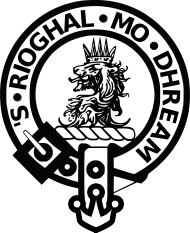 Crest: a lion's head erased Proper, crowned with an antique crown Or. | |||
| Motto | Royal is my race | ||
| War cry | Àrd-Choille | ||
| Profile | |||
| Region | Highland | ||
| District | Argyll, Perthshire Highlands | ||
| Plant badge | Scots Pine | ||
| Pipe music | Ruaig Ghlinne Freoine | ||
| Chief | |||
| Sir Malcolm MacGregor of MacGregor | |||
| The 7th baronet of Lanrick and Balquhidder (An t-Ailpeineach Mòr[1]) | |||
| Seat | Irvine House[2] | ||
| |||
| |||
| |||
History
Origins of the clan
The Clan Gregor held lands in Glen Orchy, Glenlochy and Glenstrae.[3] According to Iain Moncreiffe the MacGregors were descended from an ancient Celtic royal family, through the Abbots of Glendochart.[3] This is alluded to in the clan's motto: "Royal is my race".[3] There is also a tradition that Gregor was the brother of Kenneth MacAlpin.[3] Though there is little evidence to support this tradition[3], it is supported by the Scottish historian, William Skene,[5] It is possible that the eponymous Gregor from whom the family derives may have been Griogair, son of Dungal, who was allegedly co-ruler of Alba.[3]
Most modern historians agree that the first chief of Clan Gregor was Gregor of the golden bridles.[3] His son was Iain Camm One eye, who succeeded as the second chief sometime before 1390.[3]
The barony of Loch Awe which included much of the MacGregor lands was granted to the chief of Clan Campbell by Robert the Bruce.[3] The Campbells had already built Kilchurn Castle which controlled the gateway to the western Highlands and they harried the MacGregors who were forced to retire deeper into their lands until they were restricted to Glenstrae.[3]
16th century and clan conflicts
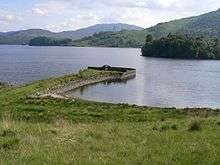
Iain of Glenstrae died in 1519 with no direct heirs.[3] He was the second of his house to be called the Black.[3] The succession of Eian was supported by the Campbells, and he married a daughter of Sir Colin Campbell of Glenorchy.[3] In 1547 Eian's son, Alistair, fought against the English at the Battle of Pinkie Cleugh but died shortly after.[3]
Colin Campbell refused to recognize the claim of Gregor Roy MacGregor to the estates, and for ten years Gregor waged a war against the Campbells.[3] He was an outlaw who raided cattle and sheltered in the high glens.[3] However, in 1570, he was captured and killed by the Campbells.[3] The chiefship was claimed by his son, Alistair, but he was unable to stem the Campbell's persecution of his kinsmen, who over time became known as the Children of the Mist, a name associated with the MacGregors due to the extent of their losses.[3]
Additionally, John Drummond, of Clan Drummond was the king's forester and was subsequently murdered after hanging a number of MacGregors for poaching.[3] The chief took responsibility for the murder and it was condemned by the Privy Council.[3]
17th century, clan conflicts and civil war
.jpg)
In response to the execution of two MacGregor clansmen in the year 1603,[6] Alasdair MacGregor marched into Colquhoun territory with a force of over four hundred men.[7] The chief of Clan Colquhoun, in response, had been granted a royal commission to suppress the MacGregors.[7] Colquhoun assembled a force of five hundred foot and three hundred horse and advanced to Glen Fruin to repel the Highland raiders.[7] MacGregor split his force in two and while the main MacGregor force and the Colquhouns engaged in combat, the second MacGregor force attacked the Colquhouns from the rear.[7] The Colquhouns were driven into the Moss of Auchingaich where their cavalry was useless and over two hundred Colquhouns were killed.[7] At the end of the eighteenth century, in an act of good will, the chiefs of the two clans met and shook hands on the very site of the former slaughter.[7]
In April 1603 James VI of Scotland issued an edict that proclaimed the name of MacGregor as "altogidder abolisheed".[3] This meant that anyone who bore the name must renounce it or suffer death.[3] In 1604, MacGregor and eleven of his chieftains were hanged at Mercat Cross, Edinburgh.[3] As a result, the Clan Gregor was scattered, with many taking other names such as Murray or Grant.[3] They were hunted like animals and flushed out of the heather by bloodhounds.[3]
An Edinburgh burgess, Robert Birrel, who kept a diary of events at the time, described the episode thus,
[MacGregor] wes convoyit to Berwick be the Gaird to conforme to the Earl's promese: for he promesit to put him out of Scottis grund. Swa [so] he keipit ane Hieland-manis promes; in respect he sent the Gaird to convoy him out of Scottis grund: But thai were not directit to pairt with him, but to fetche him bak agane! The 18 Januar, at evine [evening], he come agane to Edinburghe; and upone the 20-day he wes hangit at the Croce, and xj [eleven] of his freindis and name, upon ane gallous: Himself being Chieff, he wes hangit his awin hicht aboune the rest of hes freindis."[8]
An Act of the Scottish Parliament from 1617 stated[9] (translated into modern English):
It was ordained that the name of MacGregor should be abolished and that the whole persons of that name should renounce their name and take some other name and that they nor none of their name and that they nor none of their posterity should call themselves Gregor or MacGregor under pain of death ... that any person or persons of the said clan who has already renounced their names or hereafter shall renounce their names or if any of their children or posterity shall at any time hereafter assume or take to themselves the name of Gregor or MacGregor ... that every such person or persons assuming or taking to themselves the said name ... shall incur the pain of death which pain shall be executed upon them without favour.
Despite the savage treatment of the MacGregors, they had nevertheless fought for the king during the Scottish Civil War.[3] Two hundred men of the Clan Gregor fought for the Earl of Glencairn in what was known as Glencairn's rising, against the Commonwealth.[3] In recognition of this, Charles II of England repealed the proscription of the name, but William of Orange reimposed it when Charles's brother James VII was deposed.[3]
18th century and Jacobite risings
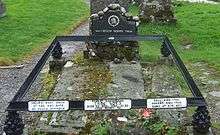
Rob Roy MacGregor was born in 1671, a younger son of MacGregor of Glengyle.[3] (However, given the circumstances, he had been forced to assume his mother's surname of Campbell).[3] The adventures of Rob Roy MacGregor have been immortalized and romanticized by Sir Walter Scott in his novel Rob Roy.[3] Rob Roy was undoubtedly a thorn in the flesh of the government until he died in 1734.[3] He supported the Jacobite cause in 1715 and after the Battle of Sheriffmuir he set out plundering at will.[3] In one such raid on Dumbarton, the town was put into panic and Dumbarton Castle was forced to open fire with its cannon.[3] He also led Clan Gregor at the Battle of Glen Shiel in 1719. He is buried in Balquhidder churchyard.[3]
During the 1745 uprising, some of Clan Gregor fought at the Battle of Prestonpans with the Jacobite army under the Duke of Perth. Some of Clan Gregor were among the Jacobite force that was defeated at the Battle of Littleferry in 1746 in Sutherland,[10] and therefore missed the Battle of Culloden that took place the next day.[11] After the rising, when the MacGregors were returning home, no-one ventured to interfere with them when they strode across Atholl, with their flying colours they strode passed Finlairg Castle where according to one source the Clan Campbell militia "durst not move more than pussies", and the MacGregors defying in broad day light the out posts which Lord Campbell of Glenorchy had established in the passes.[12] The MacGregors flaunted their weapons and returned to their old cattle-stealing ways, only being tamed over the course of time by the Commissioners of the Annexed Estates from 1755.[12]
Persecution of the MacGregors did not end until 1774, when the laws against them were repealed.[3]
19th century and restored clan
To restore pride in the clan, the chiefs needed to be re-established.[3] Eight hundred and twenty six MacGregors subscribed to a petition declaring General John Murray of Lanrick to be the true chief.[3] Murray was in fact a MacGregor who was descended from Duncan MacGregor of Ardchoille, who had died in 1552.[3] His son was Sir Evan, who played a part in the visit of George IV to Scotland in 1822, where he and his clansmen were given the tremendous honour of guarding the Honours of Scotland, better known as the Scottish Regalia and the oldest set of crown jewels in the British Isles.[3]
Clan chief
The current chief of Clan Gregor is Sir Malcolm Gregor Charles MacGregor of MacGregor, 7th Bt, of Lanrick and Balquhidder, 24th Chief of Clan Gregor.[13] His Gaelic designation is An t-Ailpeanach,[14] a name which bears testimony to the clan's traditional descent from Siol Alpin.
Clan profile
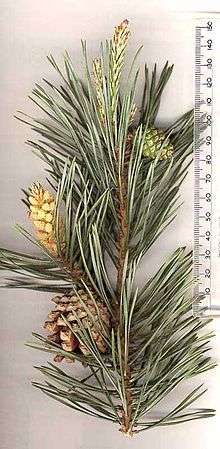
- Crest badge: The crest badge suitable for members of Clan Gregor to wear consists of the chief's heraldic crest and slogan. The chief's crest is: a lion's head erased Proper, crowned with an antique crown Or. The chief's slogan within the crest badge is 's rìoghail mo dhream ([stɾiː.əl mə ɣɾãũm]), which translates from Scottish Gaelic to "Royal is my race."[15]
- Plant badge: The clan badge or plant badge of Clan Gregor is Scots pine.[16]
Signet and seal in Iowa
Descendants of Rob Roy MacGregor settled around McGregor, Iowa, and in 1849, it was reported that the original MacGregor seal and signet was owned by Alex McGregor of Iowa. The Scottish Gaelic clan seal was inscribed, "Triogal Ma Dh'ream/Een dhn bait spair nocht", which was interpreted as "I am of royal descent/Slay and spare not". The signet was a bloodstone from Loch Lomond, and was sketched by William Williams.[17] (The "E'en do but spair nocht" bit is Scots.)
Tartans
Many tartans are associated with the name MacGregor. However, only the following are recognized as "clan tartans" by the current chief of Clan Gregor :[18]
| Tartan image | Notes |
|---|---|
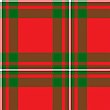 | MacGregor Red and Green. A specimen of this tartan appears in the Cockburn Collection, dating from about 1810–1820, now in the Mitchell library in Glasgow. It is one of the tartans labelled in Cockburn's handwriting in 1815. It is titled as MacGregor Murray Tartan by Wilson in the Key pattern book of 1819. James Logan titled it simply as MacGregor in 1831.[19][20] |
 | MacGregor Red and Black, also known as Rob Roy MacGregor, is the buffalo plaid of the US, associated there with the mythic lumberjack Paul Bunyan.[21] This is one of the most primitive setts of tartan. According to tartan scholar Donald C. Stewart, it is probably the oldest "MacGregor" tartan, however it was only adopted by MacGregors at a relatively late date.[22] A specimen of this tartan exists in the collection of the Highland Society of London. This piece is signed by, and bears the Seal of Arms of Sir John MacGregor Murray of MacGregor. This and other specimens of tartan kept in the collection were collected during 1815–1816, and are now kept in the Museum of Scotland, in Edinburgh.[23] The clan chief states that any MacGregor may wear this tartan.[20] |
 | MacGregor of Cardney. This is a quite modern tartan, dating from about 1920. It has sometimes been called a hunting tartan. The current clan chief states that this tartan should only be worn by the Cardney MacGregors.[20] |
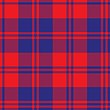 | MacGregor of Glengyle, also known as MacGregor of Deeside. A specimen of this tartan dates from about 1750.[24] The clan chief states that the Glengyle branch of the clan, or MacGregors from Deeside, are entitled to wear this tartan.[20] |
 | MacGregor Green.[25] This is a dance tartan. The chief has approved this tartan only for Highland dancers who compete, or who have competed in competitions at Highland games. The chief states that MacGregors who are not highland dancers should not wear this tartan.[20] |
Septs
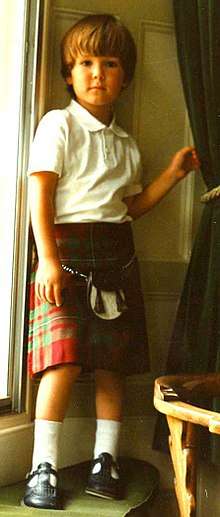
The following table lists clan names and sept names recognized by the Clan Gregor Society. The society states that people who bear the following surnames, or who descend from a woman with one of the following surnames, is eligible for membership. The prefixes M', Mc and Mac are considered interchangeable, and other spelling variations are also omitted from this list.[26]
| Alpin | Fletcher [note 1] | Greer | Gregg | Graig |
| Gregor | Gregorson | Gregory | Gregson | Greig |
| Grewer | Grier | Grierson [note 2] | Grigg(s) | Grigor |
| Gruer | Hubberd | King | Lawrence | MacAdam [note 3] |
| Macaldowie | Macara | Macaree | MacChoiter | |
| McGehee | MacConachie | MacCrowther | MacEan | MacEwin |
| MacGregor | MacGrigor | MacGrowther | MacGruder | Macilduy |
| MacLeister | MacLiver | MacNee | MacNeice | MacNeish |
| MacNie | MacPeter(s) | MacPetrie | Magruder | Malloch |
| Neish | Patullo/Pittillow | Peter [note 4] | Petrie | Gragg |
The following names are documented aliases of MacGregor from the proscription. Membership is available for individuals who can show evidence of descent or a family tradition of MacGregor connection.[26]
| Bain | Bowie | Dunn | Lockie | White |
| Beachley | Coleman | Lakie | Mor | Whyte |
| Black | Comrie | Landless | Roy | Willox |
| Bowers | Dochart | Leckie | Skinner |
The following names are traditional aliases of MacGregor with little documented evidence. Membership is available for individuals who can show evidence of descent or a family tradition of MacGregor connection.[26]
| Argyl | Crowther | Guinness | MacGrew | Peterson |
| Arrowsmith | Denison | Kirkwood | Macnocaird | Shankland |
| Begland | Docherty | Leishman | Macnucator | Stringer |
| Bowmaker | Dorward | MacAndrew | Nelson | Tainsh |
| Brewer | Dowie | MacAngus | Neilson | Telfer |
| Caird | Fisher | MacCanish | Nucator | Telford |
| Callander | Gair | MacGeach | Orr | Tossach |
| Clark | Goodsir | Macgehee | Paterson | Walker |
| Craigdallie | Grayson | Macghee | Peat | Weliver |
| Crerar | Gudger | MacGill | Peet | |
The following names are other clan names that are known to have been used by the MacGregors. People with the names from this list are properly the domain of other Clan and Family societies, however the MacGregor clan welcomes inquiries from persons bearing these names who can show their descent from a MacGregor who adopted the name as an alias.[26]
| Balfour | Ferguson | Livingston | MacInnes | Murray |
| Buchannan | Gordon | MacAlastair | MacNeil | Ramsay |
| Campbell | Graham | MacDonald | MacLaren | Robertson |
| Cunningham | Grant | MacDougal | MacNicol | Sinclair |
| Douglas | Hay | MacEwan | MacPherson | Stewart |
| Drummond | Johnson | MacFarlane | Williams | Stirling |
| Erskine | Johnston | MacIan | Menzies | Wilson |
See also
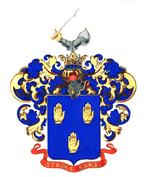
- Clan Gregor Society Pipe Band
- Siol Alpin, clans traditionally thought to descend from the brood of Alpin and thus Cináed, the first accepted King of the Scots.
- Greig (Russian nobility) , Russian noble family of Scottish origin.
- Greigia is a genus of the botanical family Bromeliaceae is named after Samuel Greig in 1864,[27] by Eduard August von Regel (a director of the St Petersburg Botanical Garden).[28] Then in 1873, Regel named a species of Tulip after Samuel Greig, Tulipa greigii.[29] Due to Greig once being president of the Russian Horticultural Society.[30]
- Atoll in French Polynesia Niau named Greig after Aleksey Greig by Russian Admiral Fabian Gottlieb von Bellingshausen in 1820.
Notes
- There is also a recognized Clan Fletcher.
- There is also a recognised Clan Grierson.
- There is also a recognized Clan Adam.
- There is also a recognized Clan Peter.
References
- Mac an Tàilleir, Iain. "Ainmean Pearsanta" (docx). Sabhal Mòr Ostaig. Retrieved 15 October 2009.
- clanchiefs.org Archived 26 July 2011 at the Wayback Machine
- Way, George and Squire, Romily. Collins Scottish Clan & Family Encyclopedia. (Foreword by The Rt Hon. The Earl of Elgin KT, Convenor, The Standing Council of Scottish Chiefs). Published in 1994. Pages 220 – 221.
- Porter, J. (2007). J. Porter, "Introduction" in J. Porter, ed., Defining Strains: The Musical Life of Scots in the Seventeenth Century. Peter Lang. ISBN 3-03910-948-0.
- Skene, William; Celtic Scotland: a history of ancient Alban, Volume 3. (1880).
- Scott, Sir W, Manners, customs and history of the Highlanders of Scotland ; Historical account of the clan MacGregor, p.121–124
- Way, George and Squire, Romily. Collins Scottish Clan & Family Encyclopedia. (Foreword by The Rt Hon. The Earl of Elgin KT, Convenor, The Standing Council of Scottish Chiefs). Published in 1994. pp. 108–109.
- W. Moir Bryce, The Book Of The Old Edinburgh Club, Edinburgh 1918, vol. X, pp. 88–89
- Black, George Fraser (1946). The Surnames of Scotland: their origin, meaning and history. [From the "Bulletin of the New York Public Library", 1943–1946.] New York: New York Public Library
- Simpson, Peter. (1996). The Highland Independent Companies, 1603 – 1760. pp. 135 – 136. ISBN 0-85976-432-X.
- Pollard, Tony. (2009). Culloden: The History and Archaeology of the last Clan Battle. p. 34. ISBN 978-1-84884-020-1.
- Duffy, Christopher. (2007). The '45, Bonnie Prince Charlie and Untold Story of the Jacobite Rising. pp. 530. ISBN 978-0-7538-2262-3. Quoting: Tullibardine, The Marchioness of (ed). A Military History of Perthshire 1600 - 1902, Perth, Glasgow and Edinburgh, 1908, I, 330.
- "Mac Gregor of Mac Gregor, Chief of Clan Gregor". Burke's Peerage and Gentry. Retrieved 18 September 2007.
- Adam, Frank; Innes of Learney, Thomas (1970). The Clans, Septs & Regiments of the Scottish Highlands (8th ed.). Edinburgh: Johnston and Bacon. pp. 539–540.
- Way of Plean, George; Squire, Romilly (2000). Clans & Tartans. Glasgow: HarperCollins. p. 190. ISBN 0-00-472501 8.
- Adam, Frank; Innes of Learney, Thomas (1970). The Clans, Septs & Regiments of the Scottish Highlands (8th ed.). Edinburgh: Johnston and Bacon. pp. 541–543.
- William Williams (1920) Major William Williams' Journal of a Trip to Iowa in 1849. Annals of Iowa 7(4).
- "The Clan Gregor Tartans". Clan Gregor Society. Retrieved 29 May 2017.
- "MacGregor WR1526". Scottish Tartans World Register. Retrieved 8 January 2009.
- MacGregor of MacGregor, Malcolm. "Our Tartans". Clan Gregor Society. Retrieved 29 May 2017.
- "Buffalo Plaid's 100-year old Mysteries Finally Solved".
- Stewart, Donald C. (1974). The Setts of the Scottish Tartans, with descriptive and historical notes (8th ed.). London: Shepheard-Walwyn. pp. 75–76. ISBN 978-0-85683-011-2.
- "Rob Roy Macgregor WR1504". Scottish Tartans World Register. Retrieved 8 January 2009.
- "MacGregor WR450". Scottish Tartans World Register. Retrieved 8 January 2009.
- "MacGregor Green WR1577". Scottish Tartans World Register. Retrieved 8 January 2009.
- "Clan Gregor Society Sept/Family Names". Clan Gregor Society. Retrieved 8 January 2009.
- A. W. Smith A Gardener's Handbook of Plant Names: Their Meanings and Origins, p. 176, at Google Books
- "Greigia Regel, Index Seminum (LE, Petropolitanus) 1864(Suppl.): 13 (1865)". kew.org. Retrieved 17 September 2017.
- "Greig's Tulip 'Chopin'". paghat.com. Retrieved 17 September 2017.
- "Tulipa greigii aurea". rareplants.co.uk. Retrieved 17 September 2017.